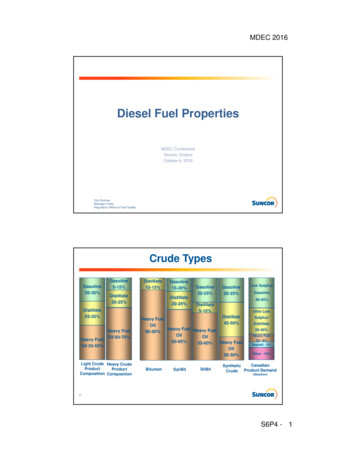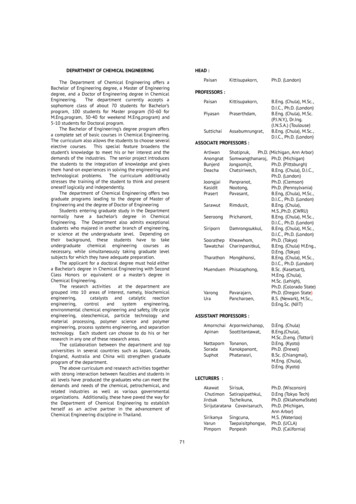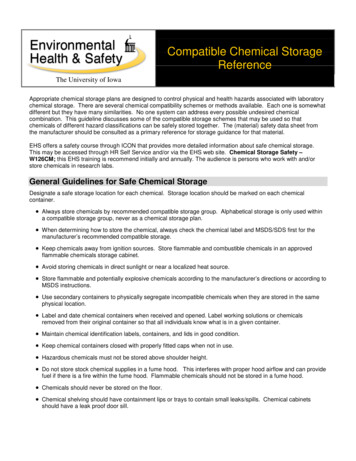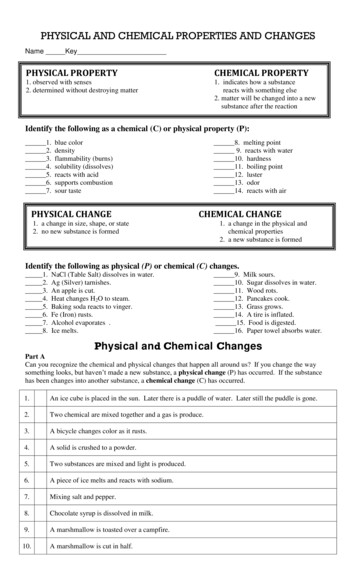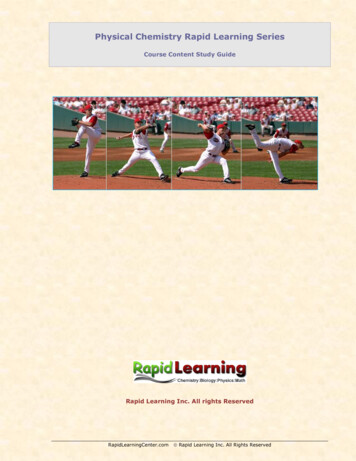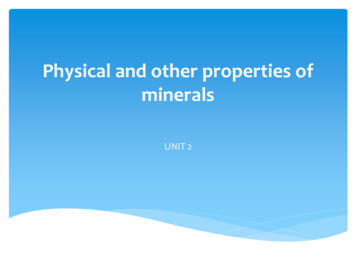
Transcription
Physical and other properties ofmineralsUNIT 2
Physical Properties of Minerals Minerals have definite crystalline structures and chemicalcompositions that give them unique sets of physical andchemical properties shared by all samples of that mineral. For example, all specimens of halite have the samehardness, the same density, and break in a similar manner. Because a mineral’s internal structure and chemicalcomposition are difficult to determine without the aid ofsophisticated tests and equipment, the more easilyrecognized physical properties are frequently used inidentification. Physical properties of the minerals in hand specimen canbe broadly divided into 3 categories: 1) Optical properties2) Crystal shape/habit and 3) Mineral strength
Physical Properties of Minerals
Optical Properties of Minerals(LUSTER) Of the many optical properties of minerals, their luster, their ability to transmit light, theircolor, and their streak are most frequently used for mineral identification. LUSTER. The appearance or quality of light reflected from the surface of a mineral is known as luster. Minerals that have the appearance of metals, regardless of color, are said to have ametallic luster . Most minerals have a nonmetallic luster and are described using various adjectives such asvitreous or glassy. Other nonmetallic minerals are described as having a dull or earthy luster (a dullappearance like soil) or a pearly luster (such as a pearl). Some others exhibit a silky luster (like satin cloth) or a greasy luster (as though coated inoil).
Optical Properties of Minerals(LUSTER)
Optical Properties of Minerals(ABILITY TO TRANSMIT LIGHT) THE ABILITY TO TRANSMIT LIGHT. Another optical property used inthe identification of minerals is the ability to transmit light. When no light is transmitted, the mineral is described as opaque. When light, but not an image, is transmitted through a mineral it issaid to be translucent. When both light and an image are visible through the sample, themineral is described as transparent.
Optical Properties of Minerals(ABILITY TO TRANSMIT LIGHT)Transparent MineralTranslucent MineralOpaque Mineral
Optical Properties of Minerals(COLOR) COLOR. Although color is generally the mostconspicuous characteristic of any mineral, it isconsidered a diagnostic property of only a fewminerals. Slight impurities in the common mineral quartz,for example, give it a variety of tints includingpink, purple, yellow, white, gray, and even black. Other minerals, such as tourmaline, also exhibita variety of hues, with multiple colorssometimes occurring in the same sample. Thus, the use of color as a means ofidentification is often ambiguous or evenmisleading.
Optical Properties of Minerals(STREAK) STREAK. The color of the mineral in powdered form, called streak, is oftenuseful in identification. A mineral’s streak is obtained by rubbing it across a streak plate (a piece ofunglazed porcelain) and observing the color of the mark it leaves. Although the color of a mineral may vary from sample to sample, its streak isusually consistent in color. Streak can also help distinguish between minerals with metallic luster andthose with nonmetallic luster. Metallic minerals generally have a dense, dark streak, whereas mineralswith nonmetallic luster typically have a light colored streak.
Optical Properties of Minerals(STREAK)
Crystal shape/habit Mineralogists use the term crystal shape or habit torefer to the common or characteristic shape of acrystal or aggregate of crystals. A few minerals exhibit somewhat regular polygonsthat are helpful in their identification. For example, magnetite crystals sometimes occur asoctahedrons, garnets often form dodecahedrons. Halite and fluorite crystals tend to grow as cubes ornear cubes. While most minerals have only one common habit,a few have two or more characteristic crystalshapes such as the pyrite.
Mineral Strength(TENACITY) Mineral Strength: How easily minerals break or deform under stress is determined by thetype and strength of the chemical bonds that hold the crystals together. Mineralogists use terms including tenacity, hardness, cleavage, and fracture to describemineral strength and how minerals break when stress is applied. TENACITY. The term tenacity describes a mineral’s toughness, or its resistance to breakingor deforming. Minerals that are ionically bonded, such as fluorite and halite, tend to be brittle andshatter into small pieces when struck. By contrast, minerals with metallic bonds, such as native copper, are malleable, or easilyhammered into different shapes. Minerals, including gypsum and talc, that can be cut into thin flakes are described assectile. Still others, notably the micas, are elastic and will bend and snap back to their originalshape after the stress is released.
Mineral Strength(HARDNESS) HARDNESS. One of the most useful diagnostic properties is hardness,a measure of the resistance of a mineral to abrasion or scratching. This property is determined by rubbing a mineral of unknownhardness against one of known hardness, or vice versa. A numerical value of hardness can by obtained by using the Mohsscale of hardness, which consists of 10 minerals arranged in orderfrom 1 (softest) to 10 (hardest). It should be noted that the Mohs scale is a relative ranking, and itdoes not imply that mineral number 2, gypsum, is twice as hard asmineral 1, talc. In fact, gypsum is only slightly harder than talc. In the laboratory, other common objects can be used to determinethe hardness of a mineral.
Mineral Strength(HARDNESS) These include a human fingernail,which has a hardness of about 2.5, acopper penny (3.5), and a piece of glass(5.5). The mineral gypsum, which hasahardness of 2, can be easily scratchedwith a fingernail. On the other hand, the mineral calcite,which has a hardness of 3, will scratch afingernail but will not scratch glass. Quartz, one of the hardest commonminerals, will easily scratch glass. Diamonds, hardest of all, scratchanything, including other diamonds.
Mineral Strength(CLEAVAGE) CLEAVAGE. In the crystal structure of manyminerals, some atomic bonds are weaker thanothers. It is along these weak bonds that minerals tendto break when they are stressed. Cleavage is the tendency of a mineral to break(cleave) along planes of weak bonding. Not all minerals have cleavage, but those thatdo can be identified by the relatively smooth,flat surfaces that are produced when themineral is broken. The simplest type of cleavage is exhibited bythe micas .Because these minerals have veryweak bonds in one direction, they cleave toform thin, flat sheets.
Mineral Strength(CLEAVAGE) Some minerals have excellent cleavage inone, two, three, or more directions,whereas others exhibit fair or poorcleavage, and still others have nocleavage at all. When minerals break evenly in more thanone direction, cleavage is described bythe number of cleavage directions andthe angle(s) at which they meet. Each cleavage surface that has a differentorientation is counted as a differentdirection of cleavage. For example, someminerals cleave to form six-sided cubes. Because cubes are defined by threedifferent sets of parallel planes thatintersect at 90-degree angles, cleavage isdescribed as three directions of cleavagethat meet at 90 degrees.
Mineral Strength(CLEAVAGE) Basal cleavage Cleavage exhibited on a horizontal plane of themineral by way of its base. Minerals with basalcleavage can sometimes be "peeled". Anexample of basal cleavage are the micaminerals. Cubic cleavage Cleavage exhibited on minerals of the isometriccrystal system that are crystallized as cubes. Inthis method of cleavage, small cubes evenlybreak off of an existing cube. An example isGalena. Octahedral cleavage Cleavage exhibited on minerals of the isometriccrystal system that are crystallized asoctahedrons. In this method of cleavage, flat,triangular "wedges" peel off of an existingoctahedron. An example is Fluorite.
Mineral Strength(CLEAVAGE) Prismatic cleavage Cleavage exhibited on some prismaticminerals in which a crystal cleaves as thin,vertical, prismatic crystals off of theoriginal prism. An example is Feldspar . Rhombohedral cleavage Cleavageexhibitedonmineralscrystallizing in the hexagonal/trigonalcrystal system as rhombohedrons, in whichsmall rhombohedrons break off of theexisting rhombohedron. An example isCalcite.
Mineral Strength(FRACTURE) FRACTURE. Minerals having chemicalbonds that are equally, or nearly equally,strong in all directions exhibit a propertycalled fracture. When minerals fracture, most produceuneven surfaces and are described asexhibiting irregular fracture. However, some minerals, such as quartz,break into smooth, curved surfacesresembling broken glass. Conchoidal fracture - breaks along smoothcurved surfaces. Such breaksfractures. Fibrous and splintery - similar to the waywood breaks.arecalledconchoidal Still other minerals exhibit fractures thatproduce splinters or fibers that arereferred to as splintery and fibrousfracture, respectively Hackly - jagged fractures with sharp edges. Uneven or Irregular - rough irregularsurfaces.
Density and Specific Gravity Density, an important property of matter, is defined as mass per unit volume. Mineralogists often use a related measure called specific gravity to describe thedensity of minerals. Specific gravity is a number representing the ratio of a mineral’s weight to theweight of an equal volume of water. Most common rock-forming minerals have a specific gravity of between 2 and 3. For example, quartz has a specific gravity of 2.65. By contrast, some metallic minerals such as pyrite, native copper, and magnetiteare more than twice as dense and thus have more than twice the specific gravityas quartz. Galena, an ore of lead, has a specific gravity of roughly 7.5, whereas the specificgravity of 24-karat gold is approximately 20.
Other properties of Minerals Magnetism: Magnetism is the characteristic that allowsa mineral to attract or repel other magnetic materials. Diamagnetic minerals- minerals not attracted by amagnet. Paramagnetic minerals - minerals attracted by amagnet. Magnetite (Fe3O4) – strongly magnetic. Ilmenite (FeTiO3) – can be weakly magnetic. Certain minerals will effervesce (bubble) when dilutehydrochloric acid is applied to the surface. This is characteristic of those minerals containing thecarbonate anion CaCO3 2HCl ‡ Ca2 H2O 2Cl- CO2 (gas). The amount of effervescence depends upon howsoluble the mineral is (calcite vs. dolomite)
Other properties of Minerals Taste: This technique can only be applied to thoseminerals which are soluble. Care must be taken in nature, for some mineralscontain arsenic, lead, and other toxic elements. Acid or sour: sulfuric acid, indicates the presence ofsulfur Alkaline: potash Astringent: (puckering) Alum Bitter: Epsom or bitter salts Cooling: saltpeter (NaNO3) Metallic: decomposed FeS2, brassy taste Saline: Salty, NaCl Some minerals exhibit special optical properties. For example, when a transparent piece of calcite isplaced over printed text, the letters appear twice. This optical property is known as double refraction
Other properties of Minerals Fluorescence: The fluorescent minerals are those that emit visiblelight when activated by invisible ultraviolet light (UV), X-rays and/orelectron beams. Example is Gypsum Phosphorescence is the ability of a mineral to glow after the initialactivating ultraviolet light is removed. Example is Fluorite Thermoluminescence is a property of some minerals to glow whenthey are heated. Example is Calcite Triboluminescence is a property of some minerals to glow when theyare crushed, struck, scratched or even rubbed in some cases.Examples are Calcite and Fluorite
sophisticated tests and equipment, the more easily recognized physical properties are frequently used in identification. Physical properties of the minerals in hand specimen can be broadly divided into 3 categories: 1) Optical properties 2) Crystal shape/habit and 3) Mineral strength Physical Properties of Minerals




